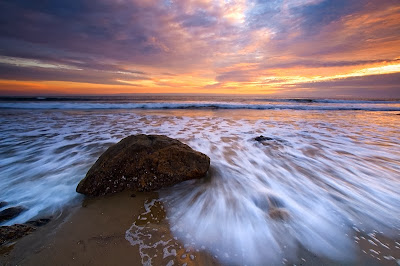As far as a creative minded photographer is concerned, seashores are one of the most happening locations one could ever dream of. There’s much drama happening there all the time, and with it comes endless photographic opportunities, the mood of the scene keeps constantly changing with the play of light, the rise and fall of tides etc.
Capturing stunning seascapes is not that hard; if you are aiming to take your photography beyond regular beach shots, here are a few tips and tricks for taking stylish, artistic seascape pictures that stand out from among-st the crowd.
Equipment Recommendations for seascape photography
Just as in Landscape photography, to create extraordinary images you need to have the right kind of equipment. Here are our recommendations.
Camera – the most obvious and most essential piece of gear
Lenses – the choice of lens depends upon the location and the effect you aim to achieve in your shots. The vast majority of seascapes are shot with wide angle lenses but the compression of view afforded by telephoto lenses could work well in certain situations.
Lens Hood – photographing seashores is one of the times when a lens hood comes in very handy, it helps eliminate flare, thereby increase contrast and also affords some protection from the sea spray.
UV Filter – in general professional photographers are divided as to whether a UV filter is necessary or not but when it comes to photographing seascapes they are all united in their opinion. Photographing seascapes could be very demanding and in order to protect your lens from the splashes and the sea spray a UV filter is an absolute must. Remember in the course of a day you may have to clean the filter/front element many times over now it’s your choice rubbing repeatedly will cause the anti glare, reflective coatings on the front element to deteriorate, but if it’s a filter you can easily replace it with another as it costs very little when compared to you lens.
Sturdy tripod and head – moving water and clouds at the beach present lot of opportunities for long exposure shots and this requires a solid tripod with a solid head. Remember to clean your equipment thoroughly after working at the beach as salt water and sand could easily damage it if left unattended.
Bubble level to level the horizon – if your tripod head has one or if your camera is one of the newer models that have a digital level then you probably won’t need one of these but if not then having one will make things very easier and they cost very little.
Spare Battery – shooting in live view, shooting long exposures, constantly reviewing shots in the cameras LCD etc could all drain batteries quickly. Always carry a fully charged spare battery with you even if you don’t use one it’s very reassuring that you have one with you if its needed.
Small headlamps or torch – if you intend to shoot in the early morning hours or late evening a headlamp could come in very handy, it will help you find your way in the dark, could help illuminate camera dials and if needed be used for light painting some foreground elements. Headlamps have the advantage over torch as they let you free both your arms.
Lens Cleaning Solution and Lens Cleaning Cloth – while shooting at the beach your lens or filter will frequently get coated with salt crystals, clean your lens/filter frequently using lens cleaning cloth and solution and do it very carefully as dry salt crystals could easily scratch your lens.
Rain Coat and Rain cover – always carry a rain cover for your camera. Keep your camera in it only take it out when you are ready to shoot and put it back as soon as you are done, it will keep your equipment safe from slat and splashes. Rain coat will help you keep dry in case it rains.
Remote Control / Cable Release – this is not an indispensable item as you can always use the self timer on your camera. But having one makes matters easier.
Essential Filters for Photographing Seascapes
Polarizing Filter
Polarizing filter could be used to cut the glare and reflections, produce more saturated colours and helps turn the sky dark blue. It could also add about 2 stops to the exposure thus serve as a 2 stop ND filter in you want to blur water.
Neutral Density Filter
Neutral density filters cuts the amount of light passing through them there by allowing the photographer to shoot at slower shutter speeds. They come in varying strengths ranging from 1 stop to 10 stops. They have no effect on colour, tone or saturation but the ability to use slower shutter speeds will help you capture movement in the clouds and blur the water.
Graduated Neutral Density Filter
When shooting seascapes the sky will always be much brighter than the foreground and this could create problems for you as a photographer. If you try to expose the sky properly you will get a dark foreground and if you try to expose the foreground correctly you will end up with a washed out (over exposed)sky. Graduated neutral density filters help you even out the exposure difference between light and dark areas in you scene. Like ND filters they also come in varying strengths, GND 0.9 (3-stops) Hard Edge and GND 0.6 (2-stops) Soft Edge filters are probably most useful ones for shooting seascapes.
Seascape Photography Tips
1. Research and study the location before shooting
Research your destination thoroughly before the actual shoot date, tourist guides, magazines, information centers etc are all helpful. But the best option is to speak to knowledgeable locals (even better if they have some photographic interests) and get your directions there may be better beaches nearby that are not frequented by tourists which only locals know about.
2. Go during Off-Season
Beaches all over the world are popular tourist destinations and they attract hordes of people. In pictures of lonely beaches is your intention visit during off season and during bad weather. Bad weather keeps tourists away but will get you great shots with character.
3. Safety first
Always inform a friend, neighbor or relative where you are going to shoot and when you could be expected back. Do carry a flash light or a head lamp with you. Check weather and tide forecasts before you set out to shoot. Never turn your back on a wave and always keep an eye on the tide. Be very careful when treading on slippery rock surfaces and make sure that you have always have an escape route in case things does not work the way as planned. Never wait till the last give yourselves ample time to get back to safety before the tide turns, things could change much faster than you ever anticipated and if it happens you’ll soon find you are in big trouble.
4. Shoot around sunrise and sunset
Undoubtedly the best times to shoot seascapes are during sunrise and sunset, arrive at your location one hour before sunrise or sunset and stay for at least an hour after sunrise or sunset to ensure you get the best lighting conditions.
5. Decide When to Shoot
Time your shot well, do your homework and find out which direction the beach is facing, this will help you decide whether it is a good idea to go during sunrise or during sunset. Also study the tide timings a perfect time to visit any beach would be when the sunrise or sunset coincides with the low tide. There are free programs like the Photographer’s Ephemeris which will tell you the time and location of sunset and sunrise anywhere in the world on any date.
6. Camp Out
If you are located far from a beach it’s always a good idea to camp out at the beach or stay at any nearby hotels so that you can easily get to the beach during early morning and capture the scene with the morning mist, followed by the golden hour light, then the sunrise and so on.
7. Depth of Field
General rule of landscape and seascape photography is to use an aperture that provides enough depth of field to get objects across the frame from the foreground to the background reasonably sharp. For this reason most commonly used aperture for photographing seascapes are f/11 or f/16. However there is no hard and fast rule, do experiment with shallow depth of field this could work well in situations where you manage to include a foreground element in your shot, focus on the foreground element and use wide open apertures to see the effect.
8. Add a Foreground Element
A plain shot with just the water and sand could turn out boring, sometimes it’ll all one could find at the seashore. But look around you may be you missed something at the first instance it could be a bottle with a message (this one you could arrange for can’t you) a piece of drift wood, a star fish, shells or simply a rock.
9. Play with Shutter Speeds
Use fast shutter speeds to freeze the motion of water that is crashing on to the rocks, this type of shots will effectively capture the fierce energy in the moment. Alternatively you can use slow shutter speeds to blur the waves and produce a surrealistic image with a dreamy feel to it. when using slower shutter speeds include some stationary foreground element to enhance the feeling of movement. Read more about blurring waterfalls and beaches with long exposure.
10. Watch the Tide
The very same beach looks entirely different during high tide and low tide, some areas looks best at high tide while some others looks best during low tide. Low tide reveals much more of the beach and underlying rocks if any, at the start of a low tide is an ideal time to shoot reflections. Visit the beaches during both tide times to see for yourselves which locations look better at what tide.
11. What to shoot at the beach?
There are endless opportunities for photography at the beach patterns in sand, sunrise, sunset, reflections in water and on wet sand, people, rocks, algae, moss, sea weed, marine life, drift woods, shore birds, waves crashing, boats and yachts, surfers, piers, light houses, puddles of water, clouds and many more keep your eyes open and opportunities will present themselves.
12. Dress appropriately
Do consider the time of the year and prevailing weather conditions while selecting dress for beach photography. If weather permits, sorts and T shirt with a jacket or photographers vest over it could be the ideal choice. It is not advisable to wear jeans or long pants as it could be quite an inconvenience if it gets wet. Also make sure you wear walking shoes that have enclosed toes, could be wet and also provides good grip over slippery rock surfaces.
13. Don't be afraid to get wet
Sometimes the most interesting angle to shoot a seascape will be from the water with the camera pointed towards the sand. So don’t be afraid to get wet if you are intent to find truly unique shooting angles. Make sure you wash your tripod legs in fresh water after every seascape photography session to prevent corrosion and also damage caused by sand getting between tripod sections. If necessary disassemble your tripod, clean everything thoroughly and assemble it back (if your tripod allows this, some tripods cannot be taken apart but most professional models can).
14. Shoot RAW
Shooting in RAW file format has a lot of advantages over shooting in JPEG. It lets you capture more detail, allows you the flexibility to change white balance in post processing and also use noise reduction function to clean up any noise caused by the long exposure.
15. Shoot in Manual Mode
The best shooting mode for photographing seascapes is the manual mode.
How you set your exposure variables depend on the intended effect. i.e. whether you want to freeze the motion or blur it. To freeze motion you’ll require faster shutter speeds, so shoot wide open and if needed bump up your ISO. And to blur motion, shoot using narrower apertures and ISO 100. Always check the histogram to determine your exposure is right.
16. Composition
Compose your frames carefully, keep them clean and uncluttered, when it comes to seascapes the simplest of the compositions are the ones that come out well. It is best to find one interesting focal point for your shot and compose your frame around it paying attention to eliminate anything else that competes with your main focal point for attention.
17. Keep Horizon Level – Always
There are no exceptions to this rule; keep your horizons level 100% of the time period.
18. Shoot in both Vertical and Horizontal Formats
Shoot your scene in both landscape and portrait orientations, do not judge which one looks better in the camera LCD, this could be done later at a large computer monitor.
19. Shoot the water at an angle
90% of all beach shots are taken head-on with the camera facing straight towards the water; instead try to shoot from an angle with the camera looking down the waterline explore creative compositions by varying the shooting height and tilt there by changing emphasis from foreground to the background etc.
20. Use Lines
Remember lines are a very important part of your composition; use leading lines to draw the eye of the viewer to the most important part of your image.
21. Dramatic Reflections
The reflection of the sun in the water during sunrise and sunsets could produce some very dramatic effects. Anticipate your shot, compose your frame in advance and be ready to shoot, shoot a sequence starting well before your indented frame and ending only after taking some more shots after that. You will never be able to judge which one came out well be looking at the small LCD, while reviewing in a bigger monitor it’ll be a different frame that impress you. It is also a good idea to bracket you exposure for critical shots.
22. Have Fun!
This is actually the most important tip of all have lots of fun, enjoy your day out at the beach and those pretty pictures you took along the way could be considered as a welcome bonus.








































